The following article about efficient disassembly was written by ME Professor Kazu Saitou for ASME’s MEMagazine. To view the full article, visit the ASME website.
There was a time when the end of a product’s life did not matter greatly to the designer. As long as the product was safe and reliable over a desired period of time, business would prosper. The expected end for every Model T or television set was a one-way trip to the junkyard or perhaps to the bottom of a body of water.
 Today, however, society’s views of the proper way to treat land and water have changed. From a strictly economic standpoint, land, materials, and water have all become too valuable to be treated like that.
Today, however, society’s views of the proper way to treat land and water have changed. From a strictly economic standpoint, land, materials, and water have all become too valuable to be treated like that.
What’s more, the regulatory environment is increasingly requiring manufacturers to consider the disposal as well as the creation of their products. Perhaps the most widely spread rules of this nature are those in the European Union governing the disposal of vehicles and electronics.
For social and legal reasons, design practices must change to accommodate more sustainable practices, in which engineers have an additional product-design goal—an economical end of life, or design for disassembly. Economic feasibility of an end-of-life (EOL) scenario of a product is determined by the interaction among retrieval cost, the value of the retrieved components or materials, and the regulatory requirements on them. While meeting regulatory requirements is obligatory regardless of economic feasibility, EOL decision making is often governed by economical considerations.
Compared to shredding followed by sorting and separation, disassembly has advantages in being able to non-destructively retrieve reusable components and to allow separation of target materials with far less contamination. However, disassembly is more expensive than shredding, especially in developed countries, since it must rely largely on manual labor due to the uncertainties in conditions of the end-of-life products in a waste stream.
Even if a component has high recycling value or high environmental impact, therefore, it may not be economically justifiable to retrieve it via disassembly if doing so requires excessive cost.
Since the cost of manual disassembly depends largely on the number of fasteners to be removed and of components to be reached, grabbed, and handled, it is highly desirable to use joints that can disengage with minimum labor, part damage, and material contamination, and to retrieve high-value or high-impact components by removing fewer fasteners and components.
These thoughts motivated my research team to develop a concept of product-embedded disassembly, a new approach to design for disassembly that aims at designing products with built-in disassembly means to be activated at the end of a product’s life. Two of the projects in this area that we have explored are the design of a new class of joints that can be detached by the application of localized heat, and the design of assemblies that can disintegrate via a domino-like process triggered by the removal of one or only a few fasteners.
